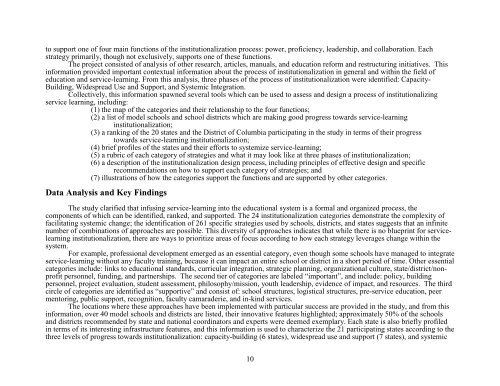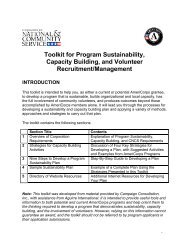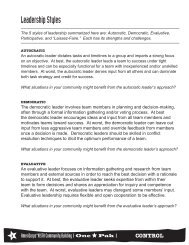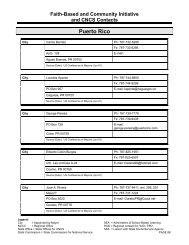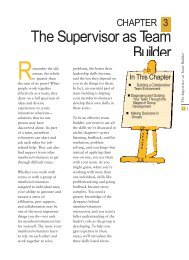MAKE IT LAST FOREVER: THE ... - National Service Resource Center
MAKE IT LAST FOREVER: THE ... - National Service Resource Center
MAKE IT LAST FOREVER: THE ... - National Service Resource Center
Create successful ePaper yourself
Turn your PDF publications into a flip-book with our unique Google optimized e-Paper software.
to support one of four main functions of the institutionalization process: power, proficiency, leadership, and collaboration. Each<br />
strategy primarily, though not exclusively, supports one of these functions.<br />
The project consisted of analysis of other research, articles, manuals, and education reform and restructuring initiatives. This<br />
information provided important contextual information about the process of institutionalization in general and within the field of<br />
education and service-learning. From this analysis, three phases of the process of institutionalization were identified: Capacity-<br />
Building, Widespread Use and Support, and Systemic Integration.<br />
Collectively, this information spawned several tools which can be used to assess and design a process of institutionalizing<br />
service learning, including:<br />
(1) the map of the categories and their relationship to the four functions;<br />
(2) a list of model schools and school districts which are making good progress towards service-learning<br />
institutionalization;<br />
(3) a ranking of the 20 states and the District of Columbia participating in the study in terms of their progress<br />
towards service-learning institutionalization;<br />
(4) brief profiles of the states and their efforts to systemize service-learning;<br />
(5) a rubric of each category of strategies and what it may look like at three phases of institutionalization;<br />
(6) a description of the institutionalization design process, including principles of effective design and specific<br />
recommendations on how to support each category of strategies; and<br />
(7) illustrations of how the categories support the functions and are supported by other categories.<br />
Data Analysis and Key Findings<br />
The study clarified that infusing service-learning into the educational system is a formal and organized process, the<br />
components of which can be identified, ranked, and supported. The 24 institutionalization categories demonstrate the complexity of<br />
facilitating systemic change; the identification of 261 specific strategies used by schools, districts, and states suggests that an infinite<br />
number of combinations of approaches are possible. This diversity of approaches indicates that while there is no blueprint for servicelearning<br />
institutionalization, there are ways to prioritize areas of focus according to how each strategy leverages change within the<br />
system. For example, professional development emerged as an essential category, even though some schools have managed to integrate<br />
service-learning without any faculty training, because it can impact an entire school or district in a short period of time. Other essential<br />
categories include: links to educational standards, curricular integration, strategic planning, organizational culture, state/district/nonprofit<br />
personnel, funding, and partnerships. The second tier of categories are labeled “important”, and include: policy, building<br />
personnel, project evaluation, student assessment, philosophy/mission, youth leadership, evidence of impact, and resources. The third<br />
circle of categories are identified as “supportive” and consist of: school structures, logistical structures, pre-service education, peer<br />
mentoring, public support, recognition, faculty camaraderie, and in-kind services.<br />
The locations where these approaches have been implemented with particular success are provided in the study, and from this<br />
information, over 40 model schools and districts are listed, their innovative features highlighted; approximately 50% of the schools<br />
and districts recommended by state and national coordinators and experts were deemed exemplary. Each state is also briefly profiled<br />
in terms of its interesting infrastructure features, and this information is used to characterize the 21 participating states according to the<br />
three levels of progress towards institutionalization: capacity-building (6 states), widespread use and support (7 states), and systemic<br />
10


